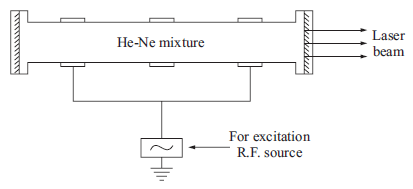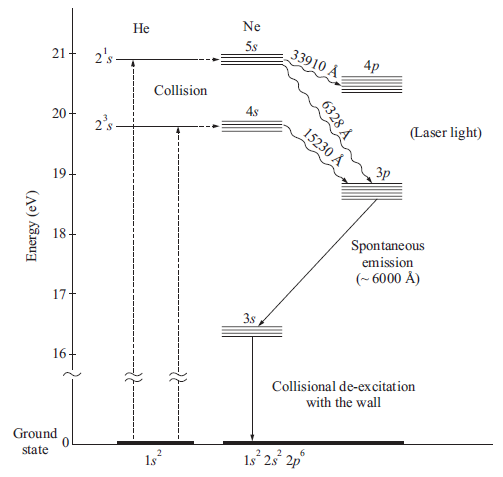Helium-neon Laser
HELIUM-NEON LASER: The helium-neon (He-Ne) laser is the first gas laser operated successfully in 1961, by Ali Javan and his co-workers at Bell Telephone Laboratories in U.S.A. It consists of the following main components.
1. Active Material: Mixture of helium and neon gases in the ratio 7 : 1 at total pressure of 1 torr (1 torr = 1 mm of Hg column) is used as an active material. However, this ratio 5 : 1 to 10 : 1 may be taken. In the mixture helium is used for population inversion only whereas levels of neon are involved in laser action.
2. Resonator Cavity: Resonator cavity is made of quartz tube of about 80 cm length and 1 cm diameter. The gas mixture is enclosed between a pair of mirrors. One mirror is completely reflecting (99.99% reflectivity) and the other mirror called the output mirror is partially transmitting (about 90% reflectivity).
3. Exciting Source: Exciting source for creating discharge in the tube is the high voltage radio frequency such as Tesla coil. As is shown below its operation involves four energy levels—three of neon and one of helium.
Operation: The working of the He-Ne laser is based on the fact that neon has excitation energy levels very close to meta-stable energy levels of helium. Few energy levels of He and Ne excited states are shown in Fig. 2.
 fig..(1)He-Ne laser
fig..(1)He-Ne laser
 fig..(2)Few energy levels of He and Ne excited states
fig..(2)Few energy levels of He and Ne excited states
Ground state of helium is 1s2. In the first excited state one of the electron goes to 2s level or the excited states are 23s (triplet) and 21s (singlet). Both the states (23s and 21s) of He are metastable states because 23s → 11s is forbidden due to change in multiplicity or flip in the spin and 21s → 11s transition is also forbidden by electric dipole transition. Ground state of Ne is 1s2 2s2 2p6 and the first few excited states are [1s2 2s2 2p5] 3s1, 4s1, 5s1, 3p1 or 4p1. When electric discharge is passed through the gas the electrons collide with the helium and neon atoms and excite them to the higher levels of both helium and neon. The helium excited states (23s and 21s) being metastable states accumulate population whereas neon has radiative decay and they come to ground state. These excited He atoms collide with Ne atoms and transfer the energy to excite Ne to 4s and 5s levels which have nearly the same energy as 23s and 21s levels, respectively, of He atoms. Thus there is resonant energy transfer. Since significant population can be built up in 4s and 5s levels, they prove suitable candidates as upper levels for laser transition. Taking account of the selection rules possible transitions are those to p-states. Transition from 5s to 4p, 4s to 3p and 5s to 3p result in the emission of radiation having wavelengths 33910 Å, 15230 Å and 6328Å, respectively. Out of these 6328 Å corresponds to visible light of He-Ne laser. The terminal 3p level decays radiatively with a life time of 10–8 sec to the 3s level of long life time. Because of long life of 3s state, atoms in this state tend to collect with time. These atoms after collision with electrons in the discharge may be excited back to 3p state which thus reduces the inversion and can even quench it. This situation may be avoided by taking tube of small diameter and then neon atoms in 3s state are de-excited by colliding with the wall of the tube. Typical power output in He-Ne lasers lie between 1 and 50 mW of continuous wave for input of about 5 to 10 W. The output shows a strong dependence on the discharge current. The power supply is thus matched with the tube.